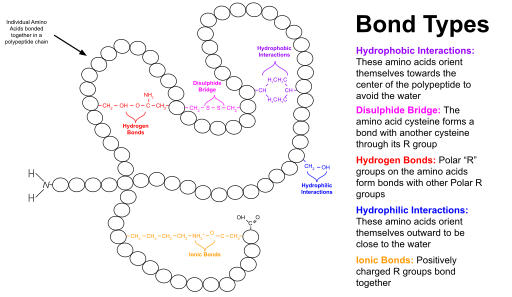Protein tertiary structure
This article needs additional citations for verification. (December 2013) |



Protein tertiary structure is the three-dimensional shape of a
History
The science of the tertiary structure of proteins has progressed from one of
Determinants
Stability of native states
Thermostability
A protein folded into its
Kinetic traps
Folding kinetics may trap a protein in a high-energy conformation, i.e. a high-energy intermediate conformation blocks access to the lowest-energy conformation. The high-energy conformation may contribute to the function of the protein. For example, the influenza hemagglutinin protein is a single polypeptide chain which when activated, is proteolytically cleaved to form two polypeptide chains. The two chains are held in a high-energy conformation. When the local pH drops, the protein undergoes an energetically favorable conformational rearrangement that enables it to penetrate the host cell membrane.
Metastability
Some tertiary protein structures may exist in long-lived states that are not the expected most stable state. For example, many
Chaperone proteins
It is commonly assumed that the native state of a protein is also the most
Cytoplasmic environment
Prediction of protein tertiary structure relies on knowing the protein's
Ligand binding
The structure of a protein, such as an enzyme, may change upon binding of its natural ligands, for example a cofactor. In this case, the structure of the protein bound to the ligand is known as holo structure, while the unbound protein has an apo structure.[8]
Structure stabilized by the formation of weak bonds between amino acid side chains - Determined by the folding of the polypeptide chain on itself (nonpolar residues are located inside the protein, while polar residues are mainly located outside) - Envelopment of the protein brings the protein closer and relates a-to located in distant regions of the sequence - Acquisition of the tertiary structure leads to the formation of pockets and sites suitable for the recognition and the binding of specific molecules (biospecificity).
Determination
The knowledge of the tertiary structure of soluble globular proteins is more advanced than that of membrane proteins because the former are easier to study with available technology.
X-ray crystallography
X-ray crystallography is the most common tool used to determine protein structure. It provides high resolution of the structure but it does not give information about protein's conformational flexibility.
NMR
Cryogenic electron microscopy
Cryogenic electron microscopy (cryo-EM) can give information about both a protein's tertiary and quaternary structure. It is particularly well-suited to large proteins and symmetrical complexes of protein subunits.
Dual polarisation interferometry
Projects
Prediction algorithm
The
A list of software for protein tertiary structure prediction can be found at List of protein structure prediction software.
Protein aggregation diseases
Protein Tertiary Structure Retrieval Project (CoMOGrad)
Matching patterns in tertiary structure of a given protein to huge number of known protein tertiary structures and retrieve most similar ones in ranked order is in the heart of many research areas like function prediction of novel proteins, study of evolution, disease diagnosis, drug discovery, antibody design etc. The CoMOGrad project at BUET is a research effort to device an extremely fast and much precise method for protein tertiary structure retrieval and develop online tool based on research outcome.[15][16]
See also
References
- ^ Branden C. and Tooze J. "Introduction to Protein Structure" Garland Publishing, New York. 1990 and 1991.
- ISBN 0-8153-1701-8
- ISBN 0-19-991083-9, 9780199910830. Accessed at Google Books 8 December 2013.
- PMID 17079131.
- PMID 12475206.
- PMID 10669617.
- PMID 20066034.
- ^ "Folding@home." Stanford University. Accessed 18 December 2013.
- ^ "Folding@home – FAQ" Stanford University. Accessed 18 December 2013.
- ^ "Folding@home – Science." Stanford University.
- S2CID 1824912.
- ^ "Tp53 Knockout Rat". Cancer. Retrieved 2010-12-18.
- ^ "Feature – What is Folding and Why Does it Matter?". Archived from the original on December 12, 2013. Retrieved December 18, 2010.
- ^ "Comograd :: Protein Tertiary Matching".
- PMID 26293226.
External links
- Protein Data Bank
- Display, analyse and superimpose protein 3D structures
- Alphabet of protein structures.
- Display, analyse and superimpose protein 3D structures
- WWW-based course teaching elementary protein bioinformatics
- Critical Assessment of Structure Prediction (CASP)
- Structural Classification of Proteins (SCOP)
- CATH Protein Structure Classification
- DALI/FSSP software and database of superposed protein structures
- TOPOFIT-DB Invariant Structural Cores between proteins
- PDBWiki — PDBWiki Home Page – a website for community annotation of PDB structures.
